View as PDF
View this email on our site
Subscribe to this newsletter
Authors: Dawn H. Gouge1, Tim Stock2, Susannah Reese3, Robert Corrigan4, Shujuan Li1, Shakunthala Nair1
1University of Arizona, 2Oregon State University, 3StopPests.org, 4Corrigan Consulting
House mice can be troublesome winter house guests. They do not hibernate and seek to enter homes when temperatures outside drop in the fall. Mice will travel along the edges of homes attracted to warmth or the smell of food. Adult mice can get through a dime-sized gap, and young mice can squeeze through smaller openings the width of a pencil. Sometimes they stay in wall voids, basements, and attic areas. However, they may also enter rooms through interior openings around pipes or conduits.
Adults (Figure 1) are small (½ - 1 ounce), grayish brown rodents measuring about 5-6 inches in length including the tail. They have a pointed snout, black, slightly bulging eyes, almost hairless ears and tail, and the tail is marked with scaly ring marks. The belly has lighter colored fur compared with the rest of the body, but it is not white.
House mice breed rapidly consuming many kinds of food (Figures 2 and 3). They need little or no water and adapt their feeding habits to the accessible resources near to their nest.
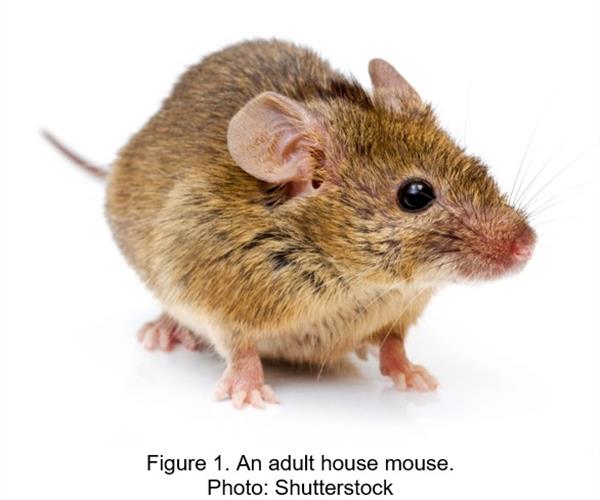
In homes house mice feed on human food, pet food, and trash they can access. Mice urinate continuously as they travel and leave droppings frequently. They contaminate food, food preparation surfaces and other areas of the home with their droppings and urine.
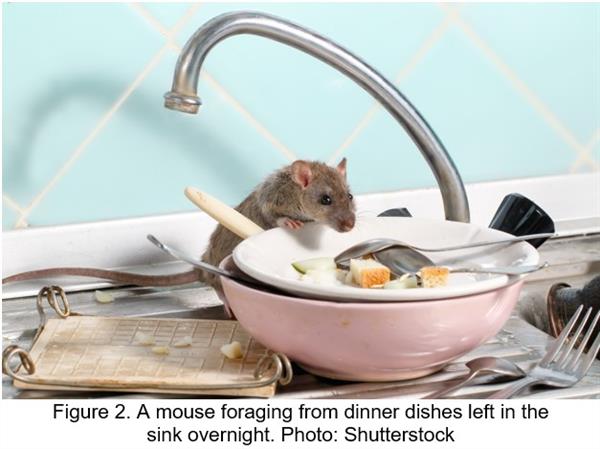
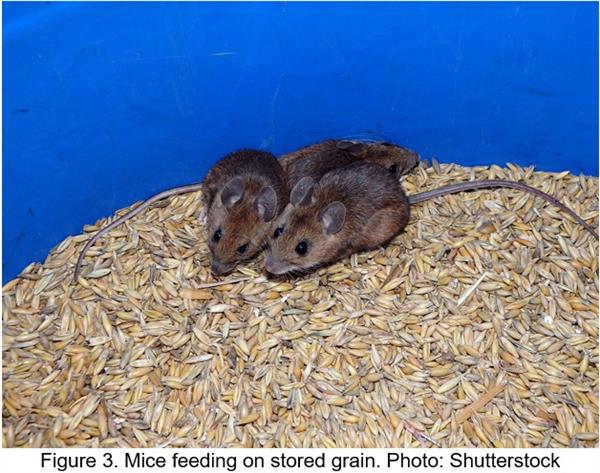
Mice will burrow into furniture (Figure 4), chew on electrical wires and wooden beams causing damage to furniture and buildings.

House mice have not been found to carry hantavirus and are not susceptible to SARS-CoV-2 infection. However, they have been implicated in the spread of other disease-causing pathogens and parasites to humans and pets. Additionally, their urine contains allergens that circulate in the air and can be asthma triggers for sensitive individuals. Therefore, house mice should not be tolerated inside homes.
So how do you know if you have house mice?
House mice are nocturnal so most active during the night. However, their antics generate several easily recognizable signs when they have moved into your home.
Droppings: House mouse droppings are between ⅛ and ¼ of an inch long, similar in size and shape to rice grains (Figure 5). They defecate at or near where they feed and near, but not in their nest. They urinate continuously producing thousands of microdroplets of urine each day. The urine fluoresces and can be seen using a black light (UV) in an otherwise dark room. However, it is important to be aware that many substances fluoresce under UV light including some cleaning solutions.
Droppings can tell us where the mice are hiding and where they usually travel. This can help you determine which entry points need sealing up, food supplies that may be contaminated, and the best locations to place traps to catch indoor mice.
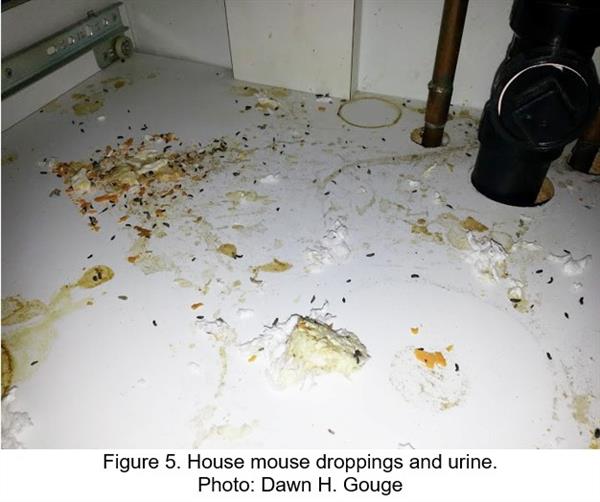
Tracks: Footprints may be found in house dust, spilt flour, or other powdery substances (Figure 6).
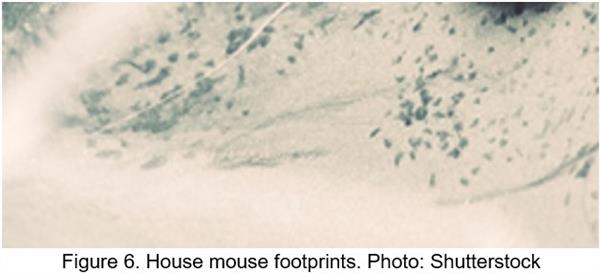
Teeth marks and chewing: Small holes in food packaging, chew marks on belongings and edges of baseboards and walls are all signs of mouse activity. Check food packaging in storage cupboards for spills and holes. Look for holes into protective voids which have tooth marks and/or fine hairs around the edges. House mice passing through entry points leave hairs attached to the edges of the openings.
Sound: Listen for quiet scampering and scratching in wall voids and above ceilings, or occasional squeaks that are inconsistent and more common at night. If sounds are consistent or predictable this indicates a mechanical or structural issue unrelated to wildlife.
Nests and stash piles: House mice build nests in undisturbed, enclosed spaces (Figure 7). They shred fabric, paper, cardboard, furniture stuffing, wool, building insulation, and plant material to form loose ball-shaped nests 4-6 inches in diameter. Chewed paper or cloth is often found in infested homes, although the actual nests may be very difficult to locate, even for pest management professionals.
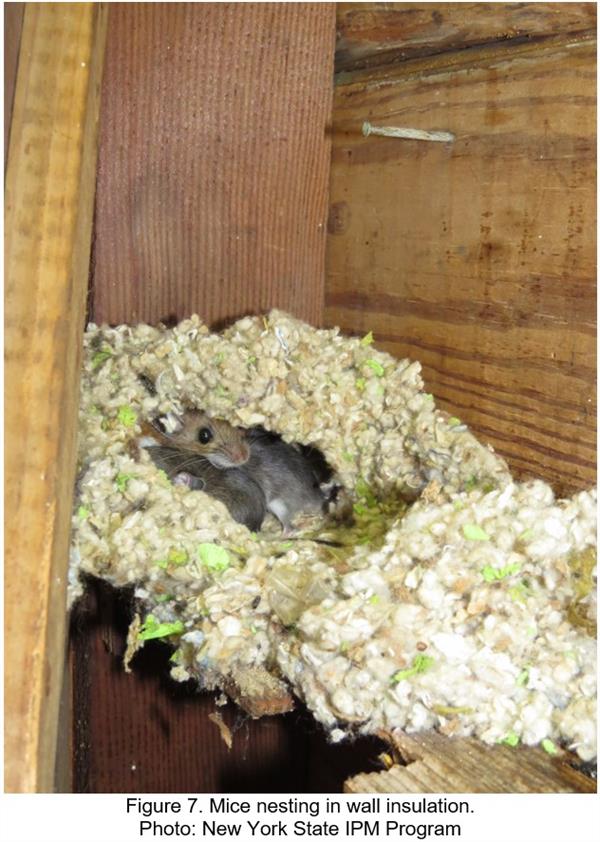
House mice will also hoard food in stash sites within their limited range of travel. So, finding piles of cached pet food, human food scraps, rodenticide bait and other edibles is quite common when an infested home is undergoing a deep clean and clutter removal.
Pantry pests including beetle and moth species as well as many other foraging insects (Figure 8) may be traced back to a house mouse food stash, nest, or dead mouse carcass.
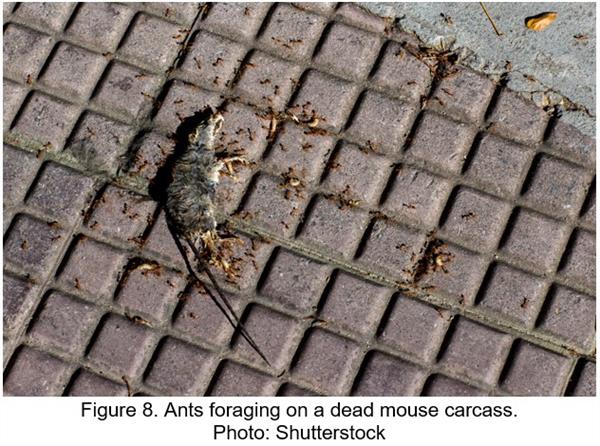
Smudge marks (rub marks): These marks occur along frequently used travel routes on baseboards, pipes, and other conduits. They darken over time as oil and dirt rubs off the rodent’s body as mice move along the same routes of travel repeatedly (Figure 9). Smudge marks contain chemicals mice use to communicate and should be removed by cleaning with soap and water.

Shredded materials: House mice will use insulation materials to nest within. They will also move insulation materials to nest sites. Finding wall void and attic insulation pulled out or in unexpected places can be an indicator of mouse activity. Mice will remove the fabric insulation found in modern stoves as this is ideal nesting material (Figure 10).

Odor: House mice have a musky ammonia smell that is often more noticeable in enclosed areas like pantries, cabinets, and drawers. The urine smell is often stronger along baseboards and walls that they move along depositing microdroplets of urine as they go. Extremely pungent odors of decay can result from dead mice as their bodies decompose.
Conclusion
If you suspect you have house mice act quickly. Get expert advice or contact a pest management company with a good track record of resolving rodent infestations in homes. An integrated pest management approach will include all of the following elements:
A publication for school facility managers can be found at https://catalog.extension.oregonstate.edu/sites/catalog/files/project/pdf/em9062_1.pdf
A publication for housing managers can be found at http://www.stoppests.org/what-is-ipm/using-ipm/property-manager-ipm-guides/.
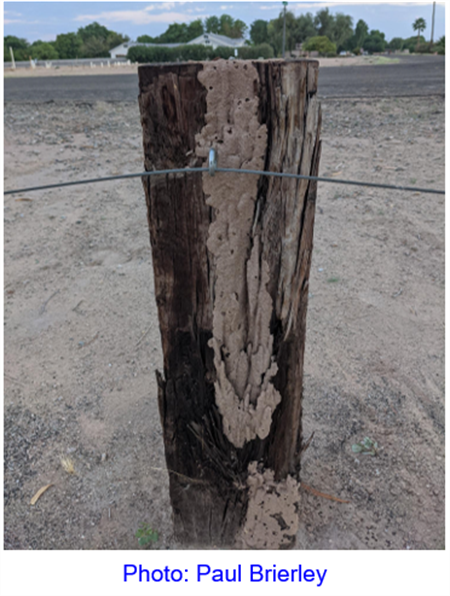

If you know what this is, email the answer to Dawn at
dhgouge@email.arizona.edu. You will not win anything if you are correct, but
you will be listed as a “Master ID Detective” in the next newsletter issue.
Hemlock trees are susceptible to infestation from a variety of pests. In this webinar, participants will learn how to identify pests that endanger hemlocks, including the hemlock wooly adelgid, elongate hemlock scale, rust diseases, hemlock tip blight, and mites. Presenters will discuss abiotic stress issues hemlock trees experience and integrated control tactics that can be implemented to maintain hemlock tree health. These tactics include cultural controls (i.e., practices that discourage pest invasion), chemical controls (i.e., the use of pesticides and biopesticides), and biological controls (i.e., the use of beneficial organisms to manage pests). 1 AZ CEU will be issued.
Register at: https://register.gotowebinar.com/register/6134908063344182542
View recordings of previous EPA Integrated Pest Management Webinars at https://www.epa.gov/managing-pests-schools/upcoming-integrated-pest-management-webinars.
For more information about the EPA Schools program: http://www.epa.gov/schools/.
To view all our previous newsletters, visit: https://acis.cals.arizona.edu/community-ipm/home-and-school-ipm-newsletters.
This material is in part funded by the National Institute of Food and Agriculture, U.S. Department of Agriculture, under award number 2017-70006-27145 that provides Extension IPM funding to the University of Arizona. Information regarding this document is within the guidelines of the Border 2020 Program funded by the U.S. Environmental Agency (EPA) and administered by NADB. Additional support is provided by the U.A. – Arizona Pest Management Center.
The Northeastern IPM Center receives support from the U.S. Department of Housing and Urban Development’s Office of Lead Hazard Control and Healthy Homes through the U.S. Department of Agriculture, NIFA agreement #2016-4866825905. Any opinions, findings, conclusions, or recommendations expressed in this publication are those of the authors and do not necessarily reflect the views of the U.S. Department of Agriculture or those of other funders.